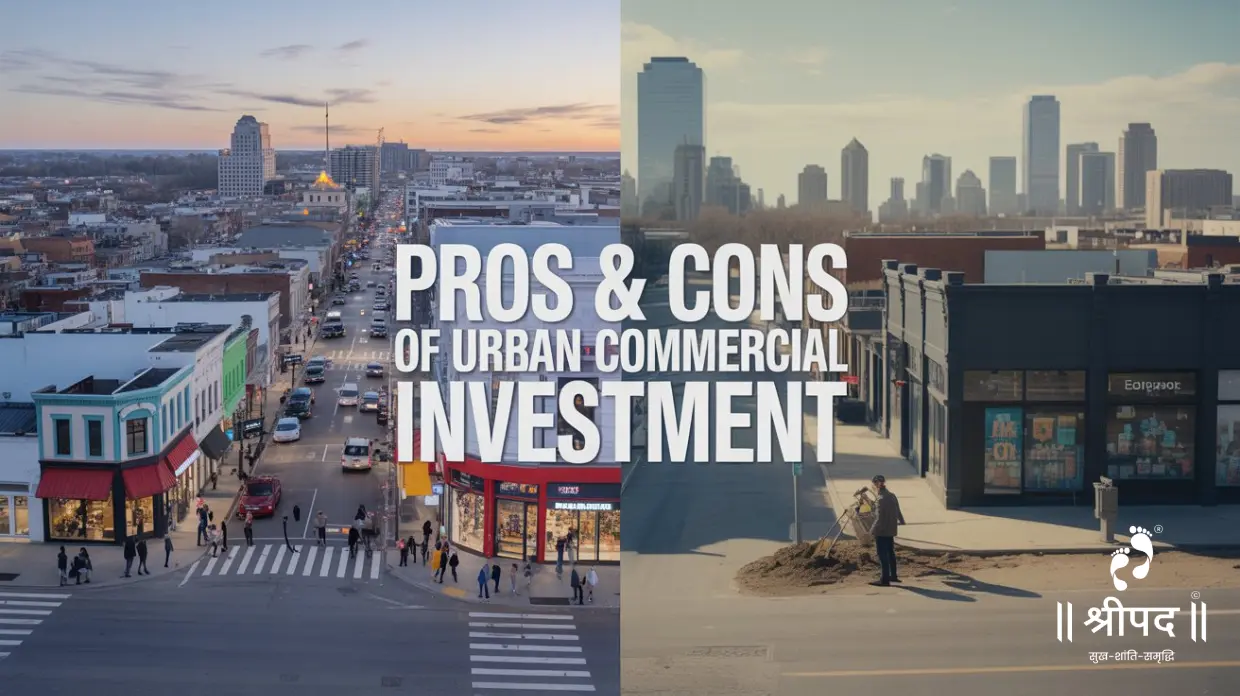- SHREEPAD GROUP
-
+91 83476 68000

Investing in commercial real estate within urban centers continues to be a popular strategy for building wealth and securing long-term income. With rising urbanization and economic development, cities have become magnets for businesses—and by extension, for commercial property investors. Yet, while city-based commercial investments offer attractive opportunities, they also come with challenges that every investor must weigh carefully.
Whether you’re a new investor or an experienced one expanding your portfolio, understanding the full scope of advantages and limitations of urban commercial property investment is crucial. This comprehensive guide will help you make informed decisions, particularly if you’re looking into dynamic markets like Surat.
Understanding Urban Commercial Property Investment
Commercial real estate refers to properties used for business or income-generating purposes rather than residential living. These can include:
- Retail units and shopping outlets
- Office buildings and business parks
- Industrial spaces and warehouses
- Hospitality venues like hotels
- Multi-use developments
Urban commercial real estate thrives on population density, business ecosystems, and infrastructure growth, making it a strategic investment choice.
Top Advantages of Investing in Urban Commercial Properties
Lucrative Rental Income
Urban properties often command higher rental rates compared to their suburban or rural counterparts. Businesses are willing to pay a premium for central locations, visibility, and access to foot traffic.
Strong Economic Ecosystem
Cities usually serve as commercial and economic hubs. The concentration of industries and infrastructure investment fuels consistent demand for commercial spaces.
Tenant Diversification
Many commercial buildings in urban areas house multiple tenants. This spreads risk and helps ensure a steady flow of income even if one unit becomes vacant.
Long-Term Leases
Businesses typically sign longer leases than residential tenants. This offers landlords greater income predictability and lower tenant turnover.
Asset Appreciation
Urban real estate, particularly in fast-developing cities like Surat, tends to appreciate steadily over time due to increased demand and limited land supply.
Operational Cost Advantages
With triple-net lease agreements common in commercial real estate, tenants often handle maintenance, insurance, and taxes—relieving landlords of these responsibilities.
Challenges of Urban Commercial Property Investment
High Entry Cost
Acquiring a commercial property in a city typically requires substantial capital. Premium locations come with hefty price tags, especially in growing urban markets.
Market Dependency
The performance of commercial real estate is closely tied to the health of the local economy. A downturn can result in increased vacancies or lease renegotiations.
Complex Regulations
Urban areas often have intricate zoning laws, building codes, and permit requirements. Navigating legal and regulatory compliance can be time-consuming and costly.
Management Complexity
Managing multiple commercial units or a high-traffic retail outlet in the city can require professional property management, increasing operational expenses.
Vacancy Risk
Urban commercial properties, especially those tailored to niche businesses, may sit vacant longer than residential ones if market conditions shift.
Reliance on Location Dynamics
The success of a commercial space in the city often hinges on surrounding infrastructure and footfall, highlighting the significant impact of location on the value of commercial property. Minor changes—such as traffic redirection or nearby development—can affect tenant demand.
Why Surat Is Gaining Ground as a Commercial Investment Hub
Surat is quickly emerging as a real estate hotbed, thanks to its strong economic foundations, textile and diamond industries, and expanding infrastructure. It’s increasingly seen as a favorable city for those looking to purchase commercial property in Surat.
Key Drivers:
- Recognition as a Smart City
- Metro rail and BRTS expansion projects
- Growing IT and business sectors
- Strong industrial zones and logistics networks
- Surging consumer spending
From bustling areas like Vesu and Adajan to upcoming IT corridors, Surat presents commercial investors with affordable yet high-potential opportunities.
Important Considerations Before Investing
To ensure success in urban commercial property investment, consider the following:
Location Suitability
Opt for properties in areas with excellent connectivity, high visibility, and strong business presence. Prime locations generally yield better returns.
Property Use Type
Decide whether you want to invest in retail, office, or mixed-use commercial property depending on the local demand and your budget.
Legal Verifications
Verify all documents, land titles, and approvals. Ensure that the property complies with all zoning and land-use laws.
Tenant Analysis
Identify the type of businesses most likely to lease your property and assess their creditworthiness and potential lease terms.
Return on Investment
Factor in rental income, property appreciation, and costs like property tax, interest on loans, and management fees to determine overall profitability.
Developer Reputation
Choose projects from trustworthy developers known for quality construction and on-time delivery. This boosts your confidence and resale value.
Urban vs. Suburban Commercial Real Estate
When comparing commercial real estate investments in urban versus suburban settings, several key distinctions emerge. Urban areas typically offer higher rental yields due to dense business activity and stronger demand from corporate tenants. In contrast, suburban areas often yield moderate rental income, which may be more suitable for investors seeking stability over aggressive growth.
However, this potential for higher income in urban zones comes at a higher entry cost. Properties in prime city locations tend to be significantly more expensive than those in suburban regions. While this increases the capital requirement, it also opens the door to greater appreciation potential, as urban properties often see consistent value growth due to infrastructure development and limited land availability.
Vacancy risks also differ. Urban commercial properties, especially those in established business districts, usually experience lower vacancy rates because of constant demand. Suburban properties may face longer vacancy periods, particularly in underdeveloped or oversupplied areas.
Tenant quality is another factor that separates the two. Urban commercial spaces often attract corporate clients and professional businesses, ensuring more structured leases and reliable payments. Suburban spaces, on the other hand, are more likely to host local retailers or small-scale businesses, which may involve shorter leases and higher turnover.
In summary, urban commercial property investment offers higher returns and long-term value but requires greater capital and risk tolerance. Suburban investments can be more affordable and stable but may not offer the same pace of appreciation or rental growth. The right choice depends on your investment goals, risk appetite, and market understanding.
Who Should Consider Urban Commercial Property Investment?
This type of investment suits:
- Entrepreneurs looking for steady passive income
- Institutional investors with large capital pools
- NRIs or remote investors seeking capital appreciation
- Established businesses wanting to own their own workspace
- HNIs (High Net-Worth Individuals) diversifying their investment portfolio
Looking Ahead: Urban India’s Commercial Real Estate Outlook
With more than 40% of India’s population expected to live in cities by 2030, the demand for urban commercial properties is bound to grow. Infrastructure developments, smart city initiatives, and digital transformation are reshaping cities like Surat into tomorrow’s business centers.
This urban shift makes commercial real estate not just a good investment, but a strategic asset for future wealth generation.
Conclusion: Should You Invest in Urban Commercial Property?
Urban commercial real estate offers high yields, long-term security, and significant appreciation—provided you enter the market with knowledge and preparation. While challenges like high entry costs and legal intricacies exist, the rewards can far outweigh the risks, especially in up-and-coming urban areas.
Cities like Surat are opening new doors for investors looking to secure future-ready assets at competitive prices. With government initiatives and private sector momentum, now is an excellent time to act.
Take the Next Step Toward Smart Commercial Investment in Surat
Considering an investment in Surat’s commercial real estate market? Trust Shreepad Group — a reputed real estate builder in Surat with a solid legacy of quality, transparency, and reliability.
We offer a handpicked selection of high-performing retail spaces, office complexes, and business-ready properties in Surat’s most promising areas.
Discover your opportunity to purchase commercial property in Surat with Shreepad Group and begin your journey toward profitable urban investment today.
See Related News & Insights Blog

30.06.2025
How Location Impacts the Value of Commercial Property
When it comes to commercial real estate investment, location plays a far more critical role than many realize. While aspects...

11.06.2025
Key Considerations Before Investing in Commercial Real Estate
Investing in commercial real estate presents a promising opportunity to grow your wealth and achieve long-term financial success. However, just...

22.05.2025
Understanding the Difference Between Residential and Commercial Properties
Real estate is a multifaceted sector that caters to a wide array of needs, from personal living spaces to profit-driven...

21.05.2025
Why Investing in Commercial Property in Surat Is a Smart Financial Move
Surat, a vibrant city in Gujarat, is rapidly evolving into a major commercial center. Traditionally recognized for its dominance in...
